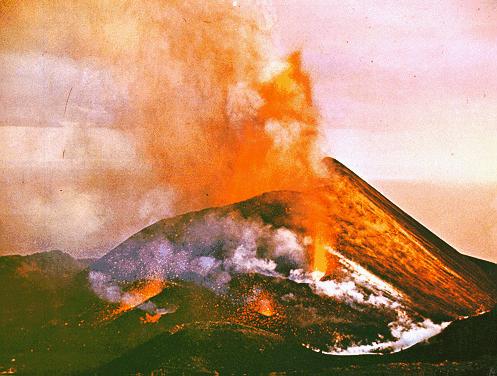 La Palma, with its beaches and mountains, is a haven for European tourists, particularly German and British middle-aged outdoorsy types. The picture above is of Los Cancajos, the area where I stayed - it's the complex in between the two stairstep looking buildings. The black sand beaches give away the island's volcanic origins. The island is basically a giant volcano (actually kind of a string of volcanoes of decreasing dormancy), with the observatories up at the top on the edge of the caldera, where the atmospheric conditions are better for staring into space. You can see the SST (where I was working) as the small squarish building third from the left, standing out against the blue ocean background.
La Palma, with its beaches and mountains, is a haven for European tourists, particularly German and British middle-aged outdoorsy types. The picture above is of Los Cancajos, the area where I stayed - it's the complex in between the two stairstep looking buildings. The black sand beaches give away the island's volcanic origins. The island is basically a giant volcano (actually kind of a string of volcanoes of decreasing dormancy), with the observatories up at the top on the edge of the caldera, where the atmospheric conditions are better for staring into space. You can see the SST (where I was working) as the small squarish building third from the left, standing out against the blue ocean background.
As you can imagine, getting from sea level up to 2,400 meters (7,800 feet) involves a road with lots of twists and turns. Especially one that does it in some 30 km. Here was my commute for the few days we went up to the observatory:
 The combination of the narrow curvy roads with blind hairpin turns every 50 feet, sudden fog, random boulders in the road, and the crazily haphazard occasional Spanish driver made this one of the more knuckle-paling, arm-tiring, concentration-demanding drives I can remember. It was beautiful, though, going from the coastal zones up through alpine forests into the above-treeline volcanic lunar landscape at the top. Here's me at the end of a little day hike one day, at the Roque de los Muchachos, the highest point on the island. Unfortunately the undercast, while neat in and of itself, was obscuring what would otherwise be a spectacular view across the caldera when I took the picture.
The combination of the narrow curvy roads with blind hairpin turns every 50 feet, sudden fog, random boulders in the road, and the crazily haphazard occasional Spanish driver made this one of the more knuckle-paling, arm-tiring, concentration-demanding drives I can remember. It was beautiful, though, going from the coastal zones up through alpine forests into the above-treeline volcanic lunar landscape at the top. Here's me at the end of a little day hike one day, at the Roque de los Muchachos, the highest point on the island. Unfortunately the undercast, while neat in and of itself, was obscuring what would otherwise be a spectacular view across the caldera when I took the picture. In addition to working up at the observatory, we had a free day to go explore the southern end of the island, where the more recently erupted volcanoes are.
In addition to working up at the observatory, we had a free day to go explore the southern end of the island, where the more recently erupted volcanoes are.
 The one shown above is Volcan Teneguia. The top photo was taken during its 1971 erupution, which shot ash and rock into the air and covered large areas around the island's southern tip with fresh lava flows. Below it is my picture from our visit - pretty cool to see the comparison, I think. Also kind of interesting was - and I think you can see a little of it in the picture, if not it may be more visible here - how the ocean on the East (left) side of the island was windswept and choppy, while the water West (right) or the island was smooth, and there's a clearly visible line extending basically due south from the island's tip where these two sections of Atlantic ocean meet.
The one shown above is Volcan Teneguia. The top photo was taken during its 1971 erupution, which shot ash and rock into the air and covered large areas around the island's southern tip with fresh lava flows. Below it is my picture from our visit - pretty cool to see the comparison, I think. Also kind of interesting was - and I think you can see a little of it in the picture, if not it may be more visible here - how the ocean on the East (left) side of the island was windswept and choppy, while the water West (right) or the island was smooth, and there's a clearly visible line extending basically due south from the island's tip where these two sections of Atlantic ocean meet.I couldn't end this post without mentioning how awesome orange juice is in Spain. Man, those folks know how to do it right. It's delicious, and the prevalence of fresh-squeezed OJ is amazing. The hotel restaurant had self-serve juice squeezing stations, with baskets of oranges next to them for you to juice to your heart's content. Zuma de naranja was a menu item everywhere, even McDonald's at the Madrid airport, where they had machines that took a few oranges and juiced them, producing a cup of fresh zuma. Mmmmm. Almost didn't come back. But I guess all good business trips must come to an end, and while I was sad to see the sun set on my last day on La Palma, it's always nice to come home.
 As usual, you can check out additional photos from my trip on my Picasa (one 's') page.
As usual, you can check out additional photos from my trip on my Picasa (one 's') page.
No comments:
Post a Comment